The third time just had to be the charm. Twice the gang had flubbed its plan to rob the mail train in Fort Worth. According to T. Lindsay Baker in Gangster Tour of Texas, one night three of the gang members had argued so long about which one of them would drive the getaway car that the mail train had rolled right past them unrobbed. Another night the gang member who had been appointed as getaway driver had gotten drunk and wrecked the getaway car.
But the night of February 21, 1933 was indeed charmed. It was golden. Acting on a tip from a retired postal worker, at 9:40 three members of the gang pulled women’s stockings over their heads and jumped out from behind a billboard beside the Main Street underpass downtown as two Railway Mail Service employees were transferring mail bags from a train at the 1931 Texas & Pacific passenger depot to the post office facility of the 1899 passenger depot. The Fort Worth Press said the robbers disarmed the two employees, then told them to “stick ’em up” and to lie down and “hug earth” for thirty minutes. The three robbers dragged seven sacks of mail to a waiting 1929 Ford on East Lancaster Avenue and escaped.
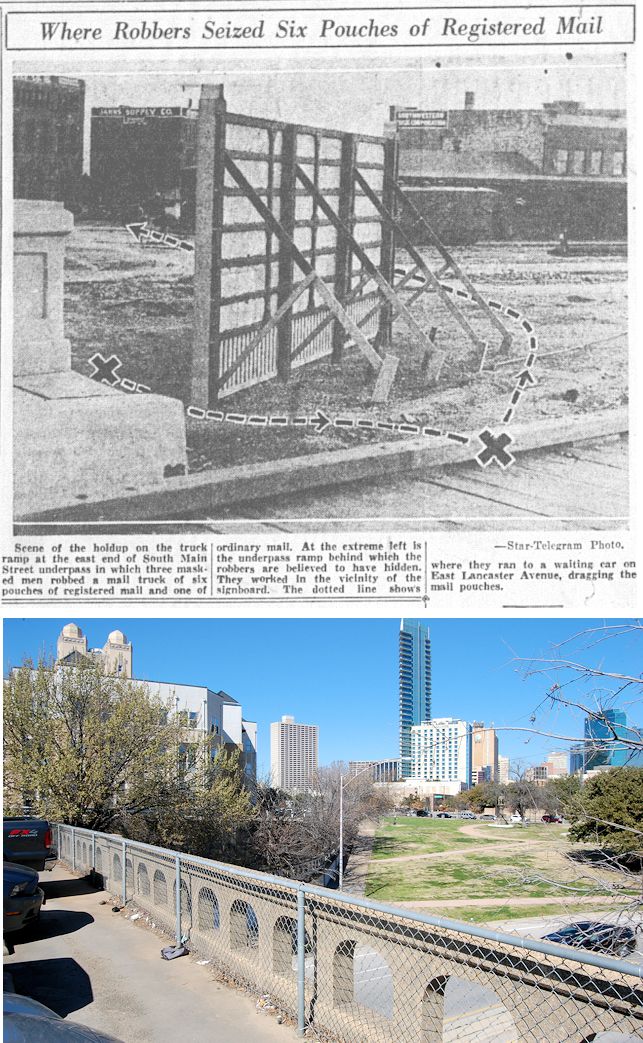 Star-Telegram photo of February 22, 1933 shows where the robbers hid on the east end of the overpass. Today that location is on the parking lot of T&P Lofts. The top of the 1931 T&P passenger depot can be seen in the upper left background.
Star-Telegram photo of February 22, 1933 shows where the robbers hid on the east end of the overpass. Today that location is on the parking lot of T&P Lofts. The top of the 1931 T&P passenger depot can be seen in the upper left background.
 The robbery was not big news in initial reports on February 22 in the Press (top), Star-Telegram, and Dallas Morning News. “Loot believed small,” said the Press. The Star-Telegram said the amount of money taken was not known. But the Morning News conceded that some people believed the mail bags “contained a large money shipment.”
The robbery was not big news in initial reports on February 22 in the Press (top), Star-Telegram, and Dallas Morning News. “Loot believed small,” said the Press. The Star-Telegram said the amount of money taken was not known. But the Morning News conceded that some people believed the mail bags “contained a large money shipment.”
“Large” indeed. In fact, the mail bags contained $71,000 ($1.2 million today) in cash from the federal reserve bank in Dallas. The money had been destined for First National Bank of Fort Worth and several smaller banks.
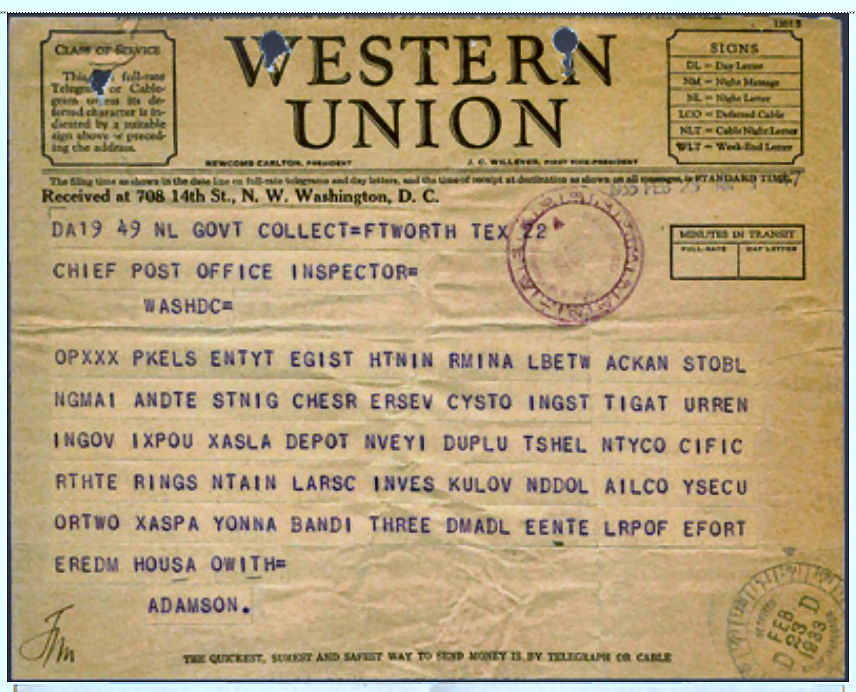
After the robbery this telegram was sent to the chief post office inspector in Washington. Decoded, the telegram reads:
“Three bandits held up railway postal clerk [Conrad T.] Black and railroad employee handling mail on mail truck conveying mail between Texas Pacific Depot and Terminal R.P.O. [railway post office], Fort Worth, Texas, last night, nine-forty, securing six pouches registered mail containing over $70,000 currency. Inspector in Charge, Austin, Tex., with post office inspector investigating. Adamson.”
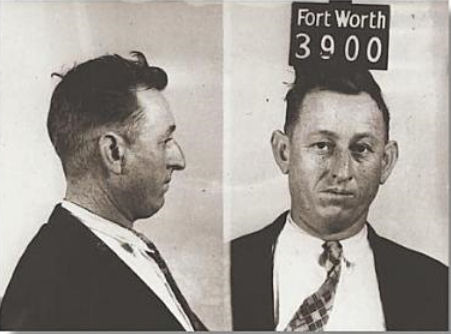
The mastermind behind this sensational crime was gang leader Olin DeWitt Stevens, age thirty-nine, although he did not take part in the actual robbery. Stevens, a Handley pharmacist, was known by neighbors as a generous family man. In 1933 neighbors did not know that in the 1920s Stevens had been a bootlegger, burglar, and car thief and had served time in Leavenworth for a narcotics violation. (Photos from University of Texas at Arlington Libraries.)
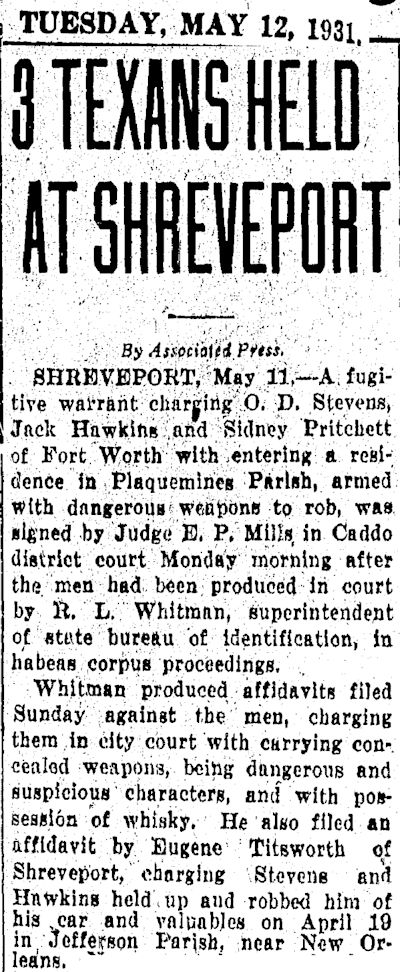 Two years earlier Stevens had been arrested for armed robbery in Louisiana.
Two years earlier Stevens had been arrested for armed robbery in Louisiana.
 During the mail train robbery of 1933 Stevens bided his time elsewhere to establish an alibi. But after the three robbers fled the scene of the robbery, they changed cars on the East Side and rendezvoused with Stevens at a house where Stevens and wife Orley and children had previously lived at 4921 Avenue E east of TWU. The 1930 census listed Stevens as a traveling salesman for a novelty company.
During the mail train robbery of 1933 Stevens bided his time elsewhere to establish an alibi. But after the three robbers fled the scene of the robbery, they changed cars on the East Side and rendezvoused with Stevens at a house where Stevens and wife Orley and children had previously lived at 4921 Avenue E east of TWU. The 1930 census listed Stevens as a traveling salesman for a novelty company.
The mail train robbery, in the depth of the Great Depression, was Stevens’s grand slam score. All that loot! But all that loot was dirty. So, Stevens the traveling salesman traveled to Chicago and New York City to sell his dirty money. He paid a fence a steep commission for clean money: $250 for each $1,000, the Star-Telegram reported. Upon his return to Handley, the newspaper said, Stevens “spent money like water.”

One thing Stevens spent money on was the completion of his fine farmhouse on ninety acres on a hill in what was then a sparsely populated rural area northeast of Handley. (Today the farmhouse is at 1408 Morrison Drive just south of Interstate 30.) But this is not your typical Green Acres farmhouse. The sandstone used in its construction was blasted from the hill. The house has fortress-thick walls of sandstone and petrified wood, hidden rooms and compartments, a trick staircase, and sliding panels. A tunnel led from the house into a nearby wooded area.
 As Stevens was masterminding the robbery and building his tricked-out farmhouse, he was also building this commercial building (also of sandstone and petrified wood) at Handley Drive and Lancaster Avenue to house his pharmacy. The pharmacy was a perfect front for his other business: illegal narcotics sales. Stevens financed construction of the farmhouse and the pharmacy with narcotics sales and money from the robbery.
As Stevens was masterminding the robbery and building his tricked-out farmhouse, he was also building this commercial building (also of sandstone and petrified wood) at Handley Drive and Lancaster Avenue to house his pharmacy. The pharmacy was a perfect front for his other business: illegal narcotics sales. Stevens financed construction of the farmhouse and the pharmacy with narcotics sales and money from the robbery.
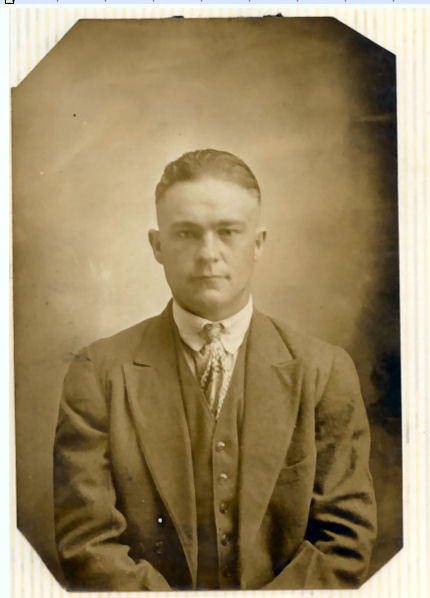
On July 8—more than four months after the robbery—two of the three robbers—Jack Sturdivant of Abilene and Harry Rutherford of Eula (near Abilene)—came to Handley and confronted Stevens. With Harry Rutherford was his older brother Jewell of Dallas (see photo). Jewell had not taken part in the robbery but went along with Harry to confront Stevens just to look after his baby brother. Jewell Rutherford would pay dearly for his devotion to family.
Jack Sturdivant, previously convicted of counterfeiting, and Harry Rutherford demanded that Stevens fork over the bulk of their share of the robbery money. Stevens stalled.
That night at Stevens’s pharmacy Stevens drank and played dominoes with Sturdivant and the two Rutherford brothers. Then Sturdivant and the Rutherford brothers followed in their car as Stevens drove toward his farmhouse.
Late that night people at a neighboring farm heard three or four gunshots.
Soon after, Jack Sturdivant’s wife Melba and Jewell Rutherford’s wife Hazel became worried and left Dallas to search for their husbands. They went to the Stevens farm more than once but found no one. When the two women finally found Stevens in Handley he claimed to know nothing about the whereabouts of Sturdivant and the Rutherford brothers.
When the two wives returned to Dallas, police were waiting for them.
The news was not encouraging.
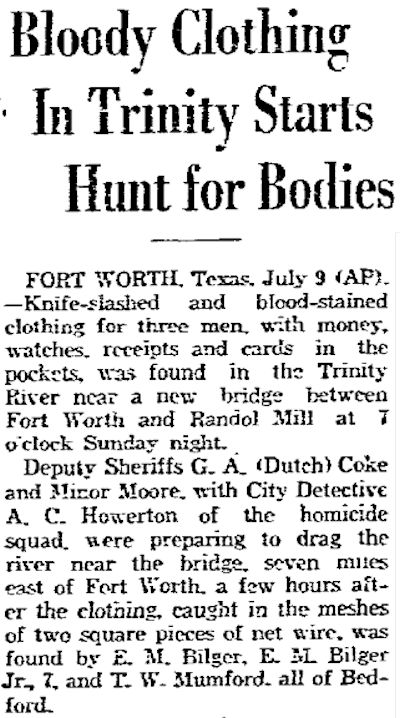 Three sets of blood-stained men’s clothing had been found near the East 1st Street bridge over the Trinity River about 4.5 miles west of the Stevens farmhouse. “It was a big bundle of hogwire,” E. M. Bilger Jr., seven, recalled in 1996 (the boy would grow up to be Bedford’s first full-time fire chief). “Wrapped inside it were clothes, boots, and jewelry. It was weighted down with two large red sandstone rocks, the same kind of rocks that the [Stevens] house was built out of.” Clip is from the July 10 Dallas Morning News.
Three sets of blood-stained men’s clothing had been found near the East 1st Street bridge over the Trinity River about 4.5 miles west of the Stevens farmhouse. “It was a big bundle of hogwire,” E. M. Bilger Jr., seven, recalled in 1996 (the boy would grow up to be Bedford’s first full-time fire chief). “Wrapped inside it were clothes, boots, and jewelry. It was weighted down with two large red sandstone rocks, the same kind of rocks that the [Stevens] house was built out of.” Clip is from the July 10 Dallas Morning News.
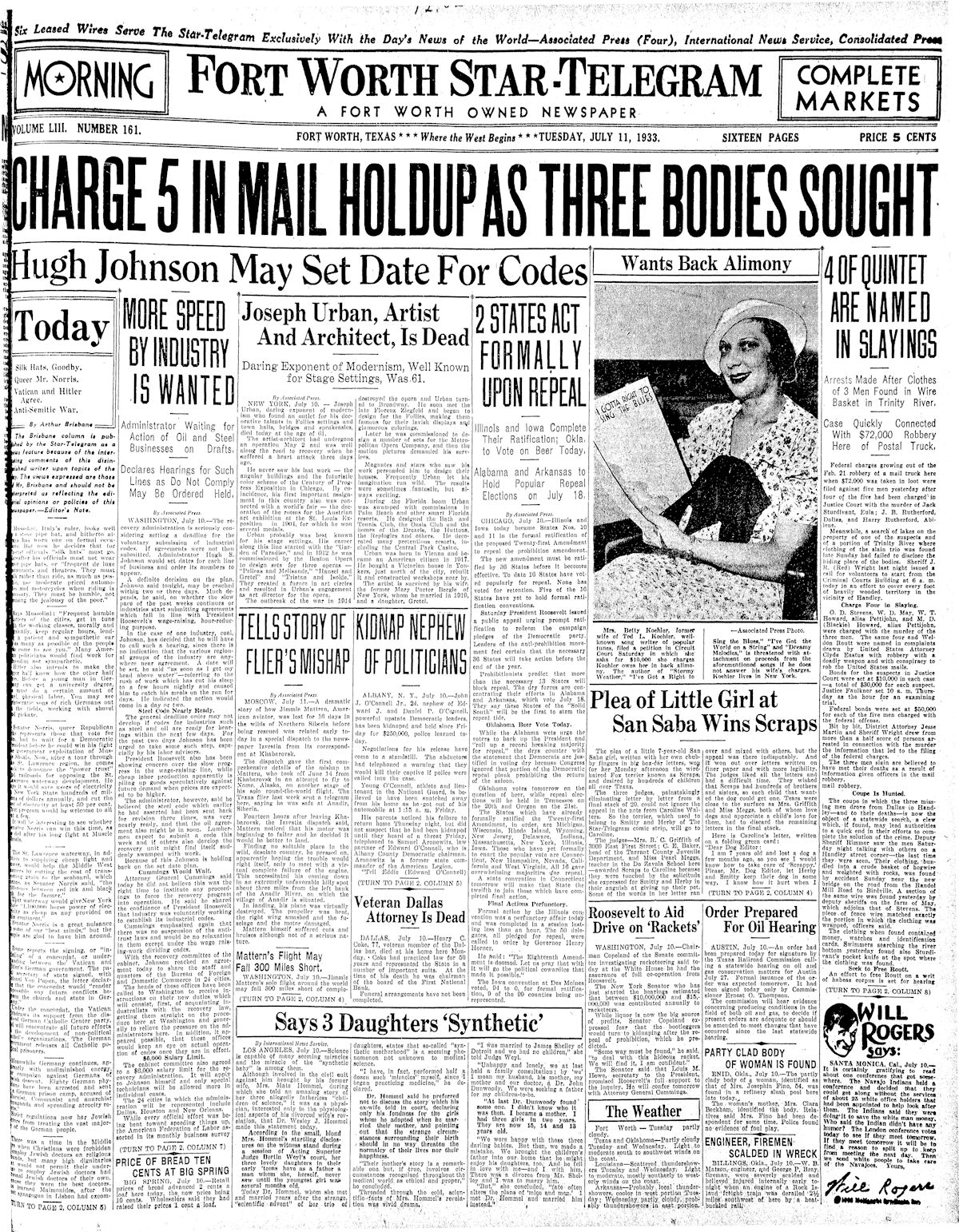 The clothes contained identification, including a card bearing Jewell Rutherford’s Dallas address.
The clothes contained identification, including a card bearing Jewell Rutherford’s Dallas address.
Jack Sturdivant’s wife Melba and Jewell Rutherford’s wife Hazel told police about the involvement of Stevens and William David May in the mail train robbery. May, previously convicted of shooting a federal officer, lived on a fifty-acre peanut farm next to the farm of Stevens. Stevens had deeded the fifty acres to May. May had been the third robber on the night of February 21, 1933. Stevens and May had met in Leavenworth in the late 1920s.
Investigators searched May’s farm and found hogwire. The hogwire that bound the clothes found in the river, the Star-Telegram reported, “matched exactly” the hogwire found at May’s farm.
Police arrested Stevens and May that day, and the search for the three missing men continued. Police officers and sheriff’s deputies searched the river and Little Fossil Creek. They also dragged a pond on the Stevens farm, and firemen pumped out a well beside the Stevens farmhouse.
 While searching Stevens’s intricate farmhouse for the three missing men, investigators found a cache of narcotics, including heroin. Clip is from the July 12 Dallas Morning News.
While searching Stevens’s intricate farmhouse for the three missing men, investigators found a cache of narcotics, including heroin. Clip is from the July 12 Dallas Morning News.
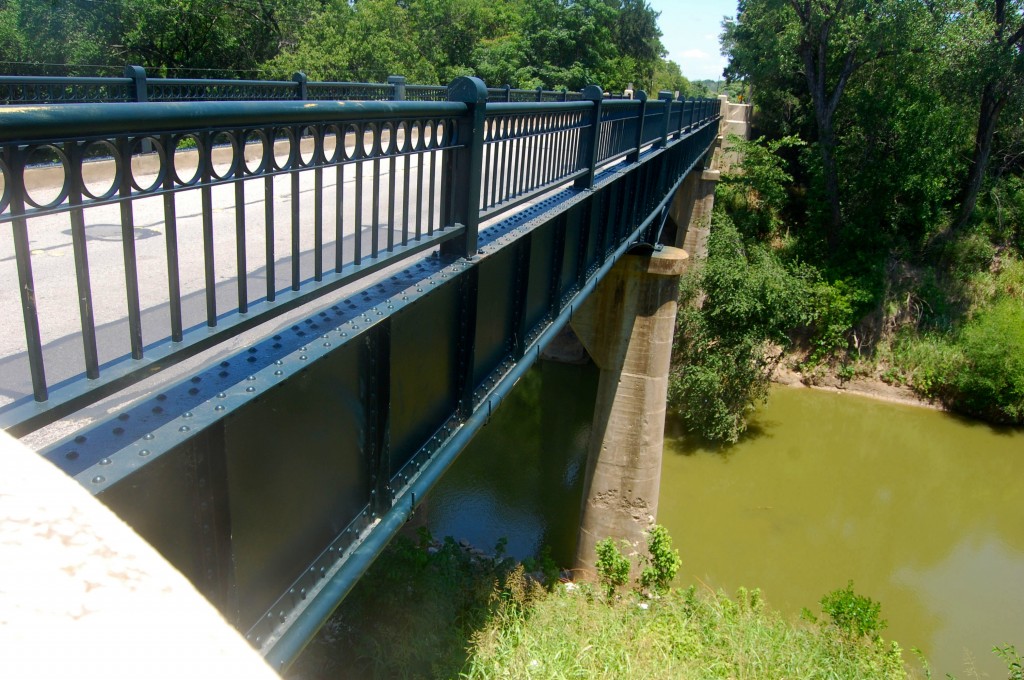
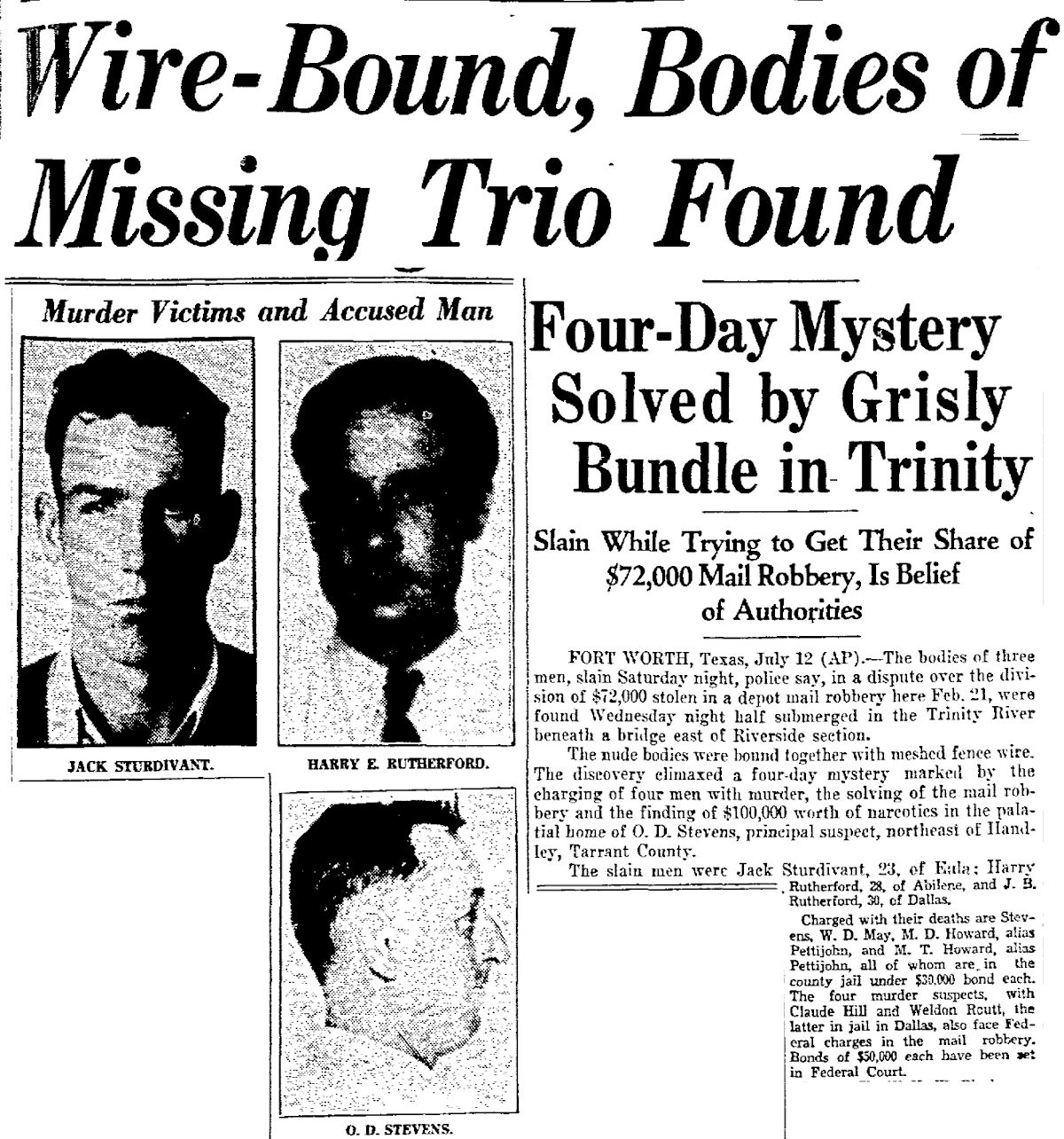 On July 11 the hogwire-bound bodies of Sturdivant and the two Rutherford brothers were found in the Trinity River at the East 1st Street bridge not far from where their clothes had been found. Stevens and May had shot the three men in the head, hauled their bodies to the bridge in a flatbed truck, and dumped the bodies, weighted with bags of cement, into the river. Clip is from the July 13 Dallas Morning News.
On July 11 the hogwire-bound bodies of Sturdivant and the two Rutherford brothers were found in the Trinity River at the East 1st Street bridge not far from where their clothes had been found. Stevens and May had shot the three men in the head, hauled their bodies to the bridge in a flatbed truck, and dumped the bodies, weighted with bags of cement, into the river. Clip is from the July 13 Dallas Morning News.
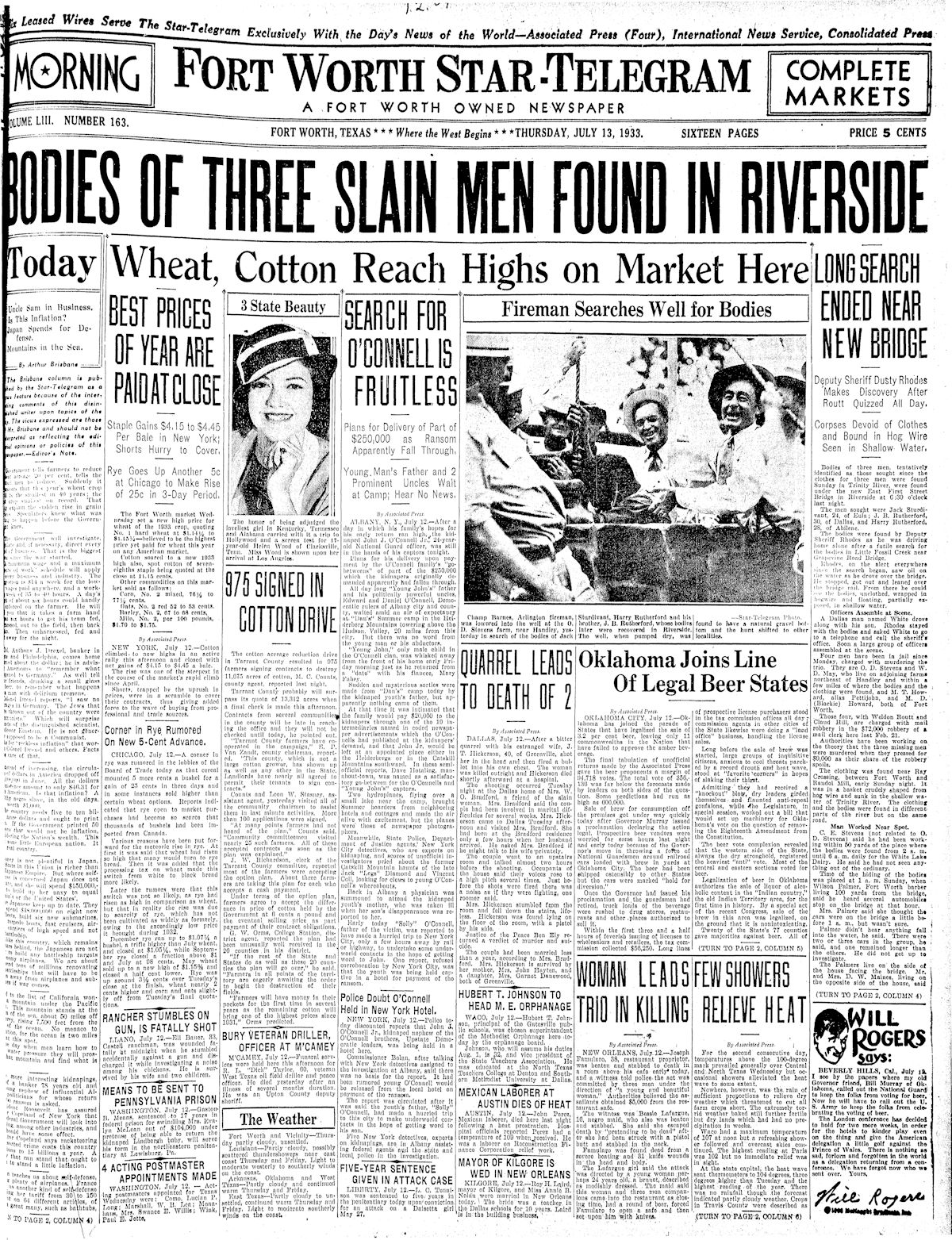 The unclothed bodies of Jewell Rutherford, thirty, Harry Rutherford, twenty-eight, and Jack Sturdivant, twenty-four, were found in shallow water. Sturdivant’s killers had cut a “Jack” tattoo from his arm to make identification of the body more difficult.
The unclothed bodies of Jewell Rutherford, thirty, Harry Rutherford, twenty-eight, and Jack Sturdivant, twenty-four, were found in shallow water. Sturdivant’s killers had cut a “Jack” tattoo from his arm to make identification of the body more difficult.
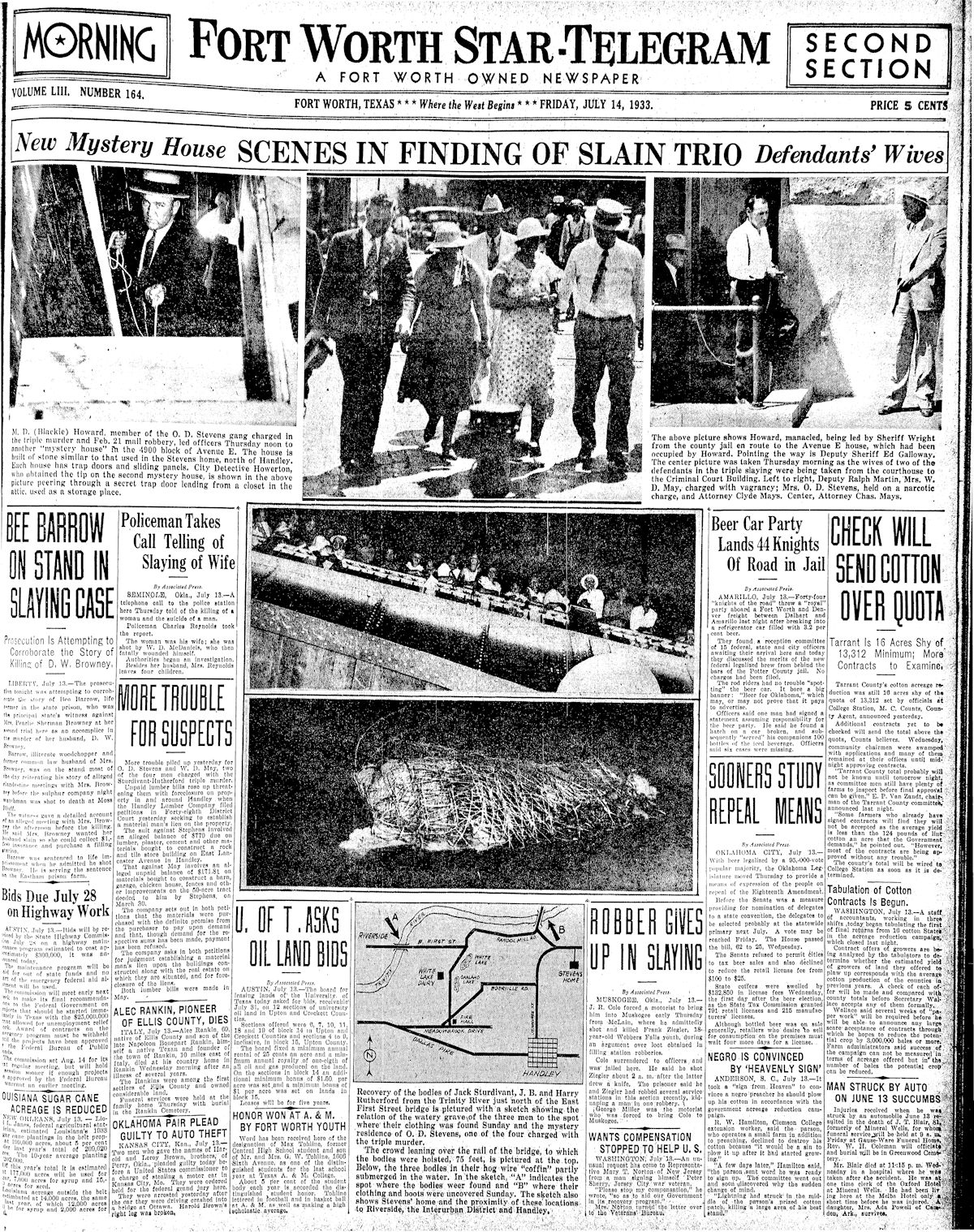
The front page of the July 14 Star-Telegram was devoted to the Stevens story. Coverage included photos of the case: Fort Worth police detective A. C. Howerton at Stevens’s Avenue E “mystery house,” which, like Stevens’s Handley “mystery house,” had trap doors and sliding panels and was built of similar stone; two wives of defendants; Stevens gang member M. T. “Blackie” Howard, who was one of thirteen people ultimately charged in the robbery (he was not indicted); a crowd at the East 1st Street bridge, and the hogwire-bound bodies. A map located the crime scenes.
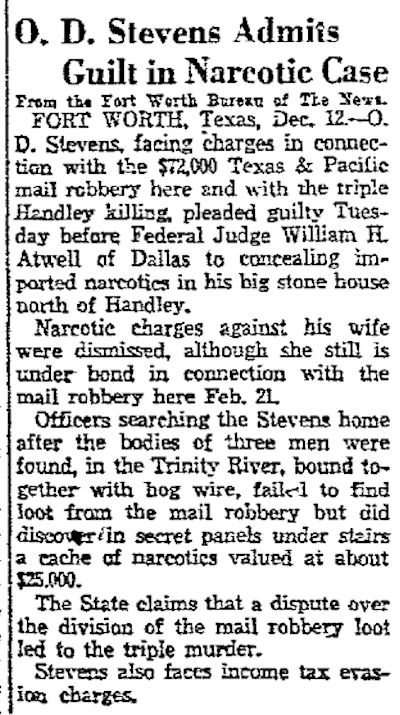 On December 13, 1933 the Dallas Morning News reported that Stevens had pleaded guilty to a narcotics charge. The News said the narcotics found in the Stevens farmhouse in July were valued at $25,000 ($444,000 today).
On December 13, 1933 the Dallas Morning News reported that Stevens had pleaded guilty to a narcotics charge. The News said the narcotics found in the Stevens farmhouse in July were valued at $25,000 ($444,000 today).
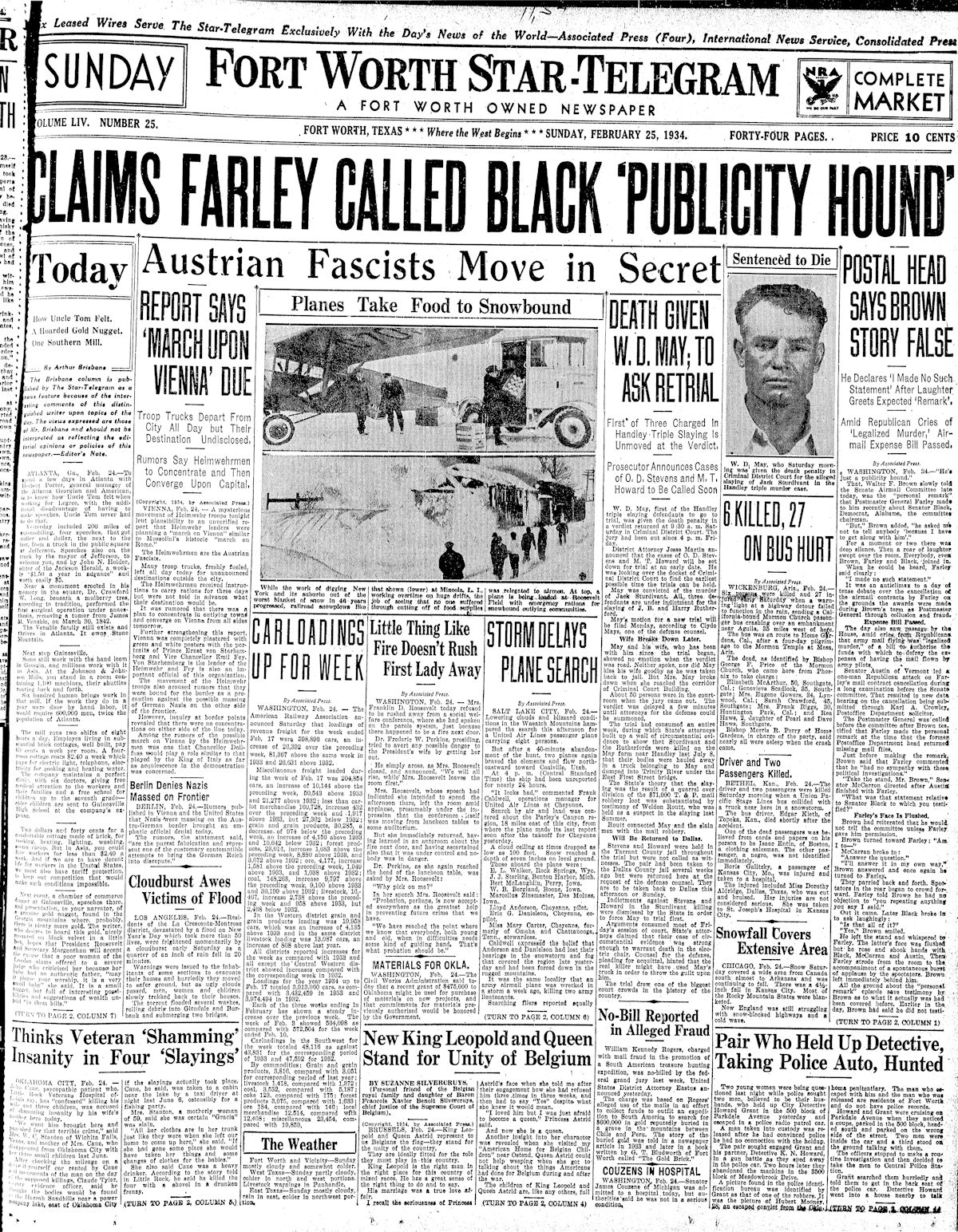 On February 24, 1934 William David May was found guilty of murdering Jack Sturdivant and given the death penalty.
On February 24, 1934 William David May was found guilty of murdering Jack Sturdivant and given the death penalty.
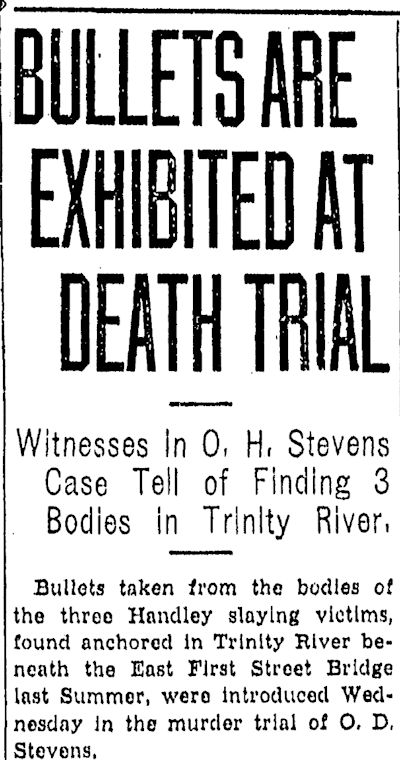 In May 1934 O. D. Stevens went on trial for the murder of Harry Rutherford. Stevens was defended by four attorneys, including an uncle. In the courtroom Stevens was kept under federal guard after attempting to break out of jail twice: While he was in jail in Dallas saw blades were smuggled in to him, and while he was in jail in Fort Worth he was able to cut through the lock on his cell door.
In May 1934 O. D. Stevens went on trial for the murder of Harry Rutherford. Stevens was defended by four attorneys, including an uncle. In the courtroom Stevens was kept under federal guard after attempting to break out of jail twice: While he was in jail in Dallas saw blades were smuggled in to him, and while he was in jail in Fort Worth he was able to cut through the lock on his cell door.
Stevens claimed an alibi. The defense produced two witnesses who testified that on the night Harry Rutherford was killed, Stevens was drinking with them in a basement “bootleg beer joint” in downtown Fort Worth.
The jury didn’t swallow it.
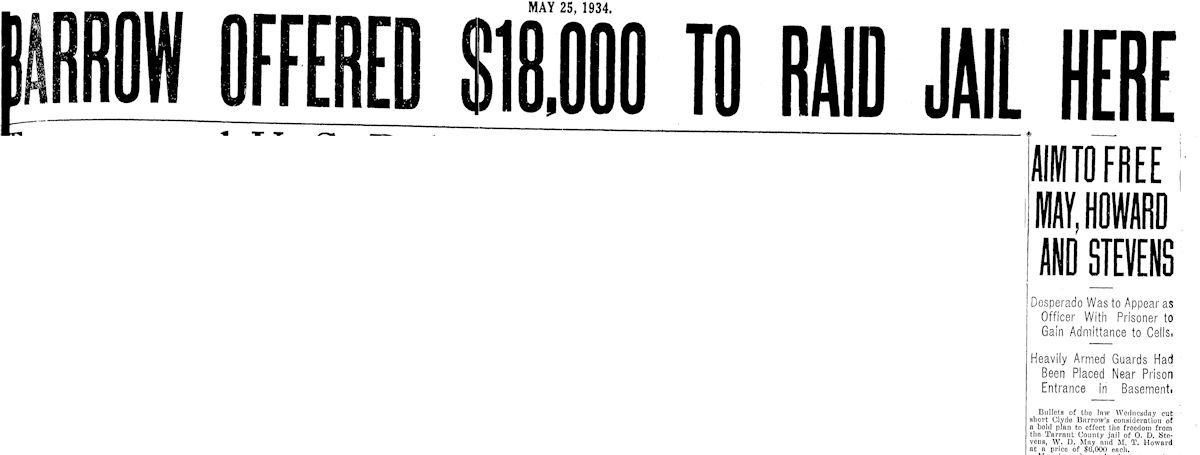 Meanwhile, authorities claimed that Stevens, impressed by Clyde Barrow’s liberation of Raymond Hamilton from Eastham prison farm, had agreed to pay Clyde $18,000 ($340,000 today) to break Stevens, May, and Howard out of the Tarrant County jail. But Bonnie and Clyde were killed before such a break could be attempted.
Meanwhile, authorities claimed that Stevens, impressed by Clyde Barrow’s liberation of Raymond Hamilton from Eastham prison farm, had agreed to pay Clyde $18,000 ($340,000 today) to break Stevens, May, and Howard out of the Tarrant County jail. But Bonnie and Clyde were killed before such a break could be attempted.
 On June 15 Stevens was found guilty and sentenced to death by electrocution. Note that Stevens shared the front page with a story about Clyde Barrow.
On June 15 Stevens was found guilty and sentenced to death by electrocution. Note that Stevens shared the front page with a story about Clyde Barrow.
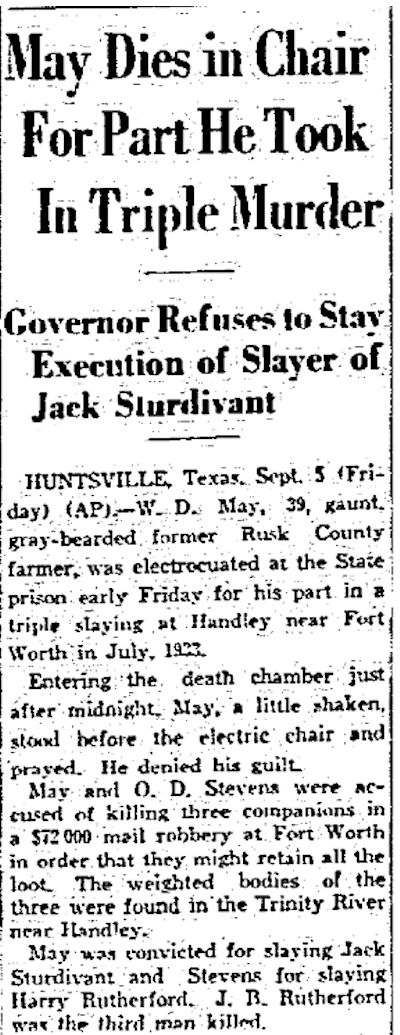
 William David May was executed in the electric chair in 1935. Clip is from the September 6 Dallas Morning News.
William David May was executed in the electric chair in 1935. Clip is from the September 6 Dallas Morning News.
Stevens avoided the death penalty when his murder conviction was overturned in 1935 because of errors by the trial judge. But Stevens was sentenced to twenty-seven years for the mail robbery and a narcotics charge. He arrived at a new maximum-security prison—Alcatraz—about the same time as Al Capone and Machine Gun Kelly (who had a hideout on Mulkey Street in Fort Worth).
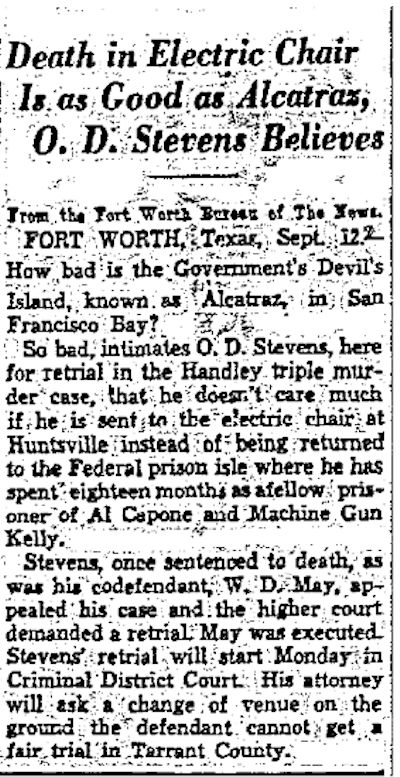 As Stevens awaited a retrial on the murder charge in 1936, he had little good to say about the guest accommodations at “the Government’s Devil’s Island.” Clip is from the September 13 Dallas Morning News.
As Stevens awaited a retrial on the murder charge in 1936, he had little good to say about the guest accommodations at “the Government’s Devil’s Island.” Clip is from the September 13 Dallas Morning News.
O. D. Stevens was acquitted of murder in his retrial and served only sixteen years in prison. He was released in 1950 and moved to Arkansas.
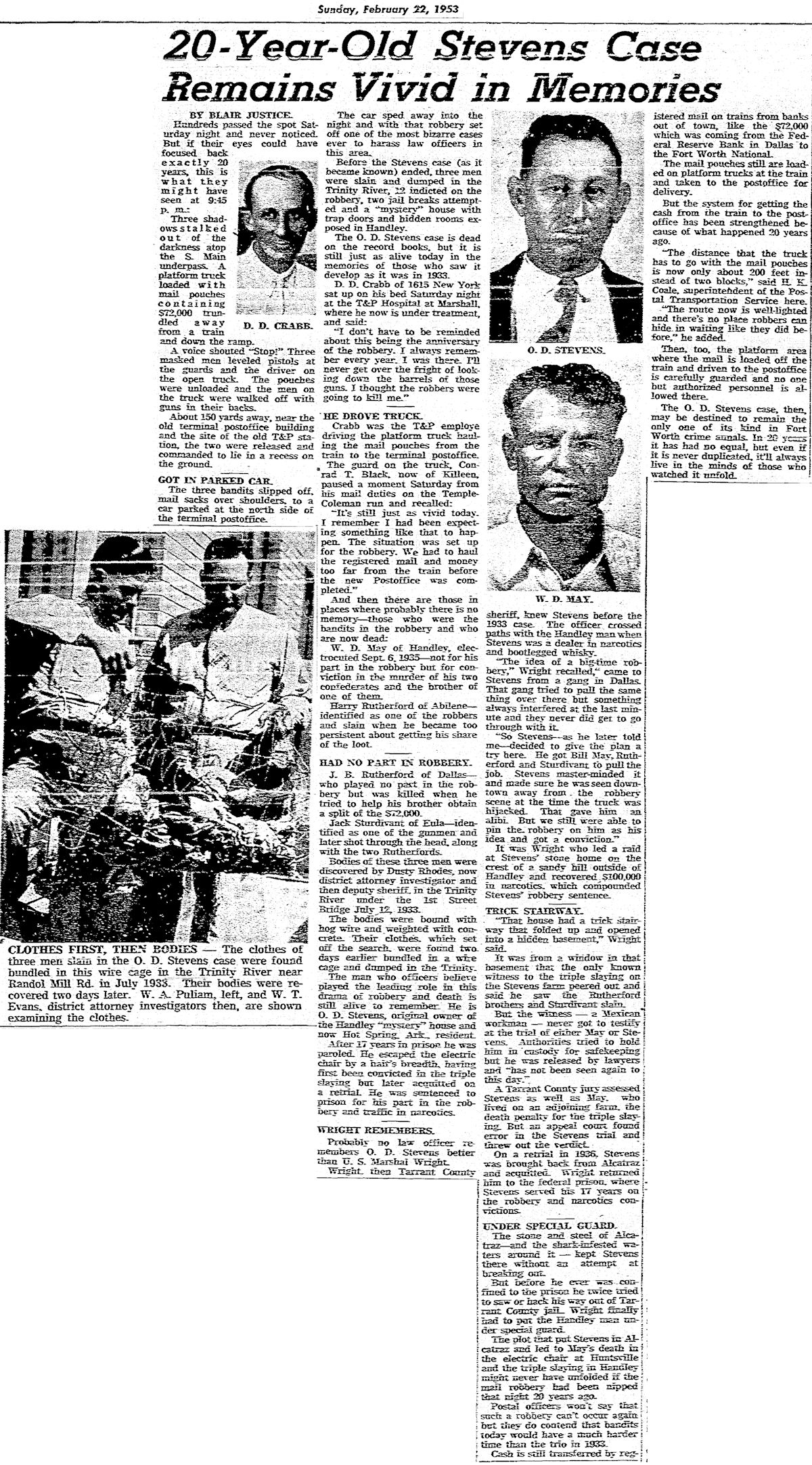 In 1953 the Star-Telegram noted the twenty-year anniversary of the robbery.
In 1953 the Star-Telegram noted the twenty-year anniversary of the robbery.
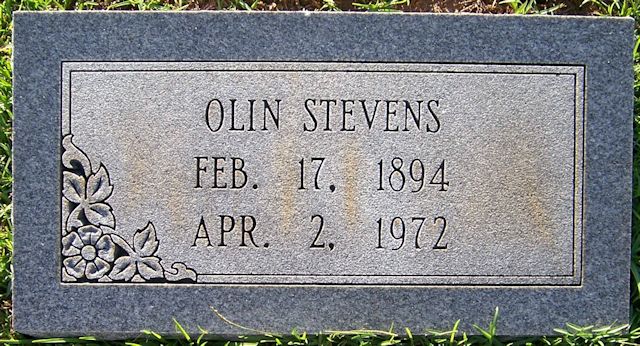 Olin DeWitt Stevens died at age seventy-eight. He is buried in his home state of Arkansas.
Olin DeWitt Stevens died at age seventy-eight. He is buried in his home state of Arkansas.
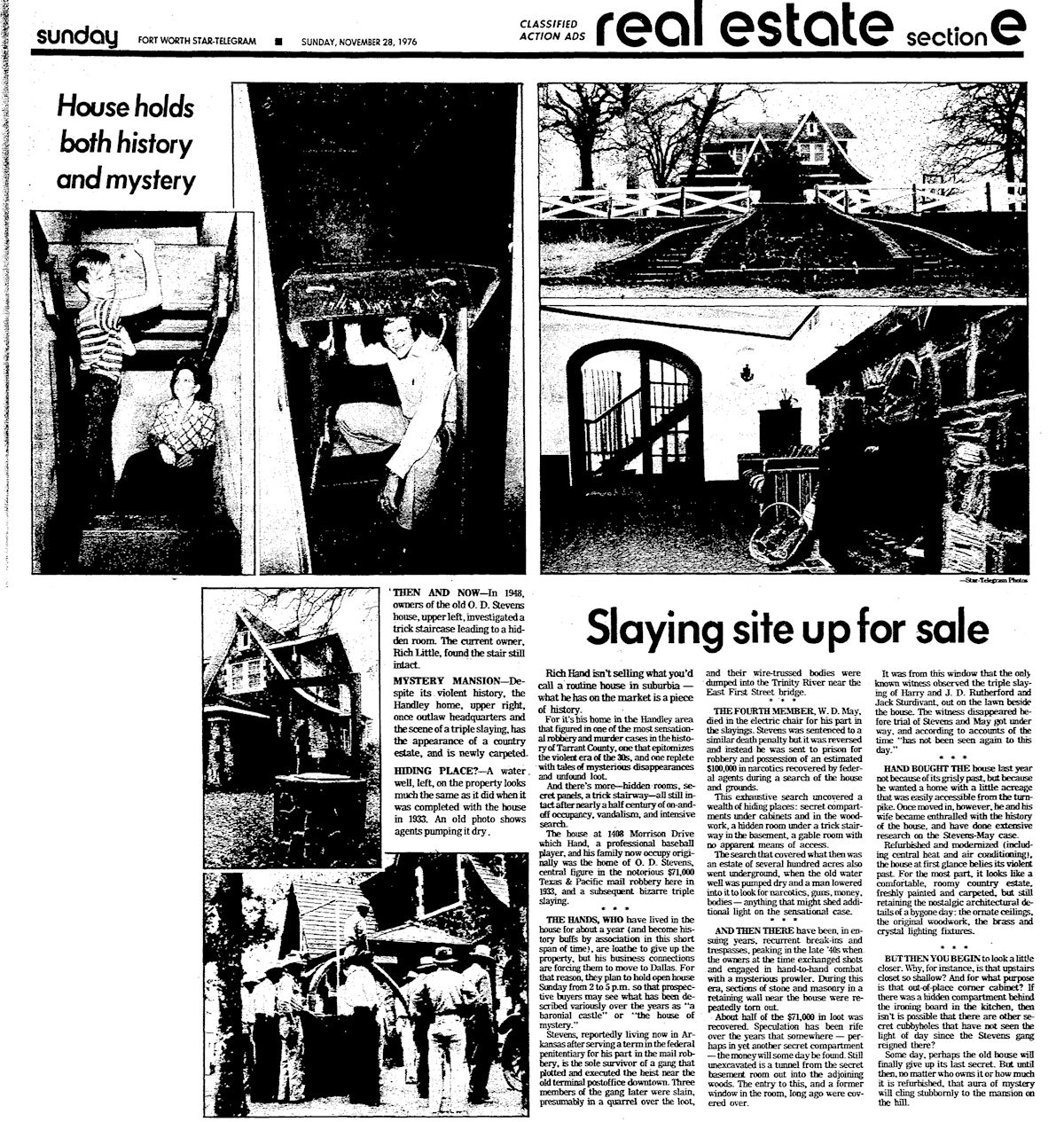 The Stevens farm has long since been sold and subdivided, and the stone farmhouse has changed ownership several times. When the house was for sale in 1976 the Star-Telegram recalled the history of the “slaying site.”
The Stevens farm has long since been sold and subdivided, and the stone farmhouse has changed ownership several times. When the house was for sale in 1976 the Star-Telegram recalled the history of the “slaying site.”
Despite searches over the years, much of the unspent robbery money has never been found, and rumors that the loot is still hidden in the house persist.
If the old house knows anything, it ain’t talkin’.
 But maybe someday an inquisitive four-year-old will get lucky: Today the farmhouse of Olin DeWitt Stevens is a Childtime preschool.
But maybe someday an inquisitive four-year-old will get lucky: Today the farmhouse of Olin DeWitt Stevens is a Childtime preschool.






This is an amazing piece of Fort Worth’s history!
I’ve searched for answers or even clues or insight into some of the people in Fort Worth’s history for many years and I don’t think that I’ve ever read anything that was written quite this wonderfully.
Thank you!
Thank you, Angela.
… this is probably the third time I have read this post, just to realize I know that bridge where they found the bundle of clothes…
… On the front page of the Star-Telegram (above) dated Fri July 14 1933 there is a map with a bridge marked “B” just North of Randol mill Rd. and West of modern “unmarked” Bridge wood st., you have a picture of this bridge in a post regarding lost sections of the Trinity river and mention it in a post “Lost lakes”…
… So, you sent me down another series of rabbit holes, to investigate a 90 years old crime, that has already been solved, just so I can tie together 2 old buildings with 2 old bridges…
… Looks like somebody’s going on a field trip, with pictures ?…
LOL. After doing this for twelve years, I get the feeling that in Cowtown everything is related to everything else. Historical people and places meet each other coming and going.
I’m wondering if Avenue E originally extended to Stop Six….Recall that the one-block-long Avenue F stops at Ayers….Recall that Avenue F from Sycamore Creek east through Poly was renamed Rosedale when the Sycamore bridge was opened….Could the thoroughfare Avenue E east of Ayers have been likewise renamed Rosedale? The house number where O. D. Stevens lived before building his minimansion was 4921 Avenue E….That would have been on the northern edge of Stop Six (when we were growing up, Rosedale was the northern boundary for Stop Six)….In our time, there used to be a traffic light at Ayers and Rosedale where Rosedale makes a slight northeasterly jog….Imponderable, I’m sure, but good fodder for guessing….And you know how I am about historic street names….
Good question, Dan. Part of the problem is that parts of town we consider inner city today were outside city limits in the 1930s and even 1940s and thus not included on city maps. FWIW, a 1936 city map shows “Avenue E” extending east to Tierney Road, which would be about the 4900 block today. A 1939 map labels that stretch “Rosedale.” Tierney was barely in the city limits in 1936.
My mother grew up in Handley. My grandfather passed away before I was born his name was Marvin Ketchum .He and his brother Curtis ran with a pretty unsavory crew back then.I was told of stories that Handley and fort Worth had a few gangsters back in the day. Anyways , my point is …wow what a good article this was.
Thanks, David. It was a heck of a passage in our history.
As a kid, my dad bought a house off Yolanda Dr. & Sandy Ln. Of course we all had bikes & would ride as far as we could in the late 60’s early 70’s If I remember correctly,we would ride east on Brentwood Stair to Morrison, here the timber was so thick & the roads nothing but Sugar sand you would almost sink to your knees in. Going north on Morrison, the home was on the left. Just across the road were a few out buildings & a deep water well made of the same sandstone. It wasn’t filled in & us kids always thought about one of the bodies or maybe even the loot was in that well. I never got run off the property on the well side, but if us kids got just a foot or so on the properties west side, we were quickly run off. Back in 1969-1971 or so, this area was in the Boondocks, you were literally in a part of the “Cast Iron Forest”
This is a wonderful piece of Fort Worth history!
Thanks, John. The wild West never died. It just traded horses for cars.
I find these articles so very interesting.
I have had the privilege of knowing Jack Sturdivants family and visiting his gravesite.
There are several bits of information I would like to share with you.
In the mid-1980s I was a contractor in Ft. Worth. I had a shop on Ederville Rd., right down the street from the OD Stevens property on Morrison Drive. I was hired to remodel the house for a group of investors who were turning the house into a restaurant.
During the time we worked on the house both myself and members of my crew searched that place high and low, inside and out, looking for the elusive bounty from the train robbery, or any other bits of historical significance.
Never did find the loot but we did locate all of the hidden rooms, nooks and crannies; the lookout perch in the attic with the gun portals built into the stone walls and even the entrance to the underground tunnel that led from the basement of the house to the field north of the house.
The entrance to the tunnel had been sealed off with a concrete wall by that time and try as I might I could not get the owners to let us bust out the concrete so we could see where the tunnel led.
All in all it is one of the grand stories in the annals of Ft. Worth’s colorful history and what a great job of telling the story Mike Nichols has done.
Thanks, Carson. You have had a glimpse of Fort Worth history that few of us have had.
This is so very interesting to me.
I owned a ranch that was Jack Sturdivants grandparents. There are several things pertaining to him that the family has shared with me. I find this so interesting, knowing what I found myself.
I have also visited his gravesite several times.
Please return my email or give me a call.
I’d love to know more.
Thank you so much,
Tina Roland
I currently work in this home. It is now a Preschool.
A lot of history in that old stone house. The post mentions that the house is now a preschool.
I am the granddaughter of Melba (not Melva) Rutherford. I just wanted to let you know that you have her name spelled incorrectly several times in your story. Thanks.
Thank you for the correction. I have made the two changes. The “Melva” spelling comes from T. Lindsay Baker’s Gangster Tour of Texas.
I owned the house in the late seventies. We turned it into a restaurant named the Texas Connection. I have many memories and stories of the house. It was haunted. Fires would start in the fireplace, hair dryers would just turn on by themselves.
My Father had told me some of this tale while I was growing up. He was E.M. Bilger Jr, the 7 year old boy who found the clothing in the river along with my Grandfather and Uncle Tommy. I’d never heard the entire story of this and I would love to thank you for this information. My Father had always told me that this incident is what inspired him to become a police officer with Fort Worth, retiring after 30 years there to become the first paid Chief of the Bedford Fire Department. Thank you so much.
It’s a wild story. I bike over that bridge every Saturday and always think of the scene your father saw.
Thank you for such a well written piece. I am related to “Big Bill” May and have been collecting information on him over the last few years. I am not sure if you know this, but one of the incriminating factors in the trial was that after the birth of a boy William David Jr was born Feb 7 and died Feb 8, leaving a debt to the hospital. Feb. 21 is the date of the robbery. He the paid the hospital bill in full.
Thanks for that detail, Ms. Hughes. I had not come across that.
Stephanie,
William David May was my great Uncle. D.H.May was my grandfather. Harold “Foots” Hughes was my cousin. My Aunt Lois (Harold’s mother) lived across the street
and Harold and family (Billy Dove, Stewart, David, Jamey, Mason) lived a few houses down across the street. Wonderful family, Harold and Billy Dove so caring and in love. They sang together at volunteer fire department
follies in Lone Star, Texas. so wonderful time in our lives. Miss them, never new what happened to David or John Mason. Such tragedy for Jamey, heard Stewart died in his childhood home there (perhaps broken heart).My father was Jack(J.T.) May, Harold’s
3rd cousin. Dad and Foots had history together. Believe Harold was reason we moved from Arkansas to Texas, maybe Harold got dad a job at the steel plant.
Olin Stevens etched a self-portrait into a metal bar on Alcatraz Island while he was being held in an A-Block isolation cell. I would be happy to post a photo of it if you tell me where.
Thank you, Michael. I have contacted you by e-mail.
I also enjoyed reading this article. W.D.May was my great uncle. His brother, E.H. May was my grandfather and my father was John W. May.
Thanks for the article. I learned more about the history of the family.
Thanks, Danny. A memorable episode in our history.
Great article, I am into Genealogy and this article is very interesting to me because W.D. May is my husbands Uncle Bill. I have longed for more information on this story, and this is great.
Thank you for your article
Thanks. I bicycle over the old East 1st Street bridge often and always think of that incident.
Neat article, My great grandfather was William David May. His Son (My grandfather) WD May Jr raised us kids. I have heard many stories about this and love trying to find new information. Thank you for your article.
Thank you, Brandi. T. Lindsay Baker also has a chapter in Gangster Tour of Texas.
It’s an amazingly small world. I was reading your blog and recognized your name. We moved to Raleigh about 11 years ago, so it’s great reading so much about the town I grew up in.
Oh yes, the duck wound healed. 🙂
Great to hear from you, Jay. The old family farm is now a Fox and Jacobs housing addition, and I worry that any minute they are going to tear ME down and put up a young person.
My wife worked at the Morrison house in the 90s when it was a Children’s Courtyard. She got to see the hidden rooms and sealed off tunnels. We were just talking about the history of that home, but we only have a cloudy memory of the stories. We started doing research, via Google, and found this post!! Thanks for this! What a great and informative read.
-Jay
Jay: Thanks. It’s a story I had never heard while growing up on the East Side with your dad.
P.S. Sorry my duck bit you all those years ago!
I find the laundering part odd because my great-grandfather’s obituary from 1935 says my great-grandfather, a Fort Worth police officer at the time, found 50,000 of the loot under the Summit St Bridge after following Stevens’ girlfriend.
One of the frustrations of historical research is the fact that seldom do all accounts of a historical event agree on all details. One detailed account of the crime that includes laundering is T. Lindsay Baker’s “Gangster Tour of Texas.” Baker says the total amount stolen was $71,000, of which 25 percent was paid to the launderer as commission.
I am surprised at how many people with my same name are criminals and psychoes. there appeare to be 7500 of us existing today in the u.s. 14 of us are child molesters including a specific individual named olin dudley stevens. i have noticed many who have my same first name have a police record. so apparenly their is a lot in a name.perhaps this should be a lesson to mothers who wish to dabble in unpopular names. I was named after my grand father who was one of the early settlers in eastern washington. i believe he was running from his name and did not knowit
I am always amazed by how many people have the same first, last, and even middle names. And are not even related. There have always been several Mike Nicholses in this area (electrician, teacher, iron worker, etc.), and I have often gotten phone calls meant for them. Judging from those calls, the other Mike Nicholses lead far more interesting lives.
Who says: Handley has no heroes! 😉